- 製品情報
- スミカスーパー LCP
- LCPの射出成形機・金型設計
スミカスーパー LCPの射出成形機・金型設計
射出成形機の選定
スミカスーパーLCPは、通常のインラインタイプの射出成形機やプランジャー(プリプラ)タイプの射出成形機で成形することが可能です。ただし、E5000シリーズのみ成形温度が最高420℃になるため、高温仕様(450℃仕様)の成形機が必要です。
スクリュ、シリンダ
- スミカスーパーLCPのグレードの多くはガラス繊維を充填しているため、耐摩耗性の材質を推奨します。
- スクリュデザインは、標準的なフルフライトタイプが適します。サブフライト付きスクリュや高混練スクリュの使用は、計量時間が長くなるため適しません。
- 代表的なスクリュデザインは、下記の通りです。
L/D(スクリュの長さ(L)/スクリュの径(D)):18~22程度
圧縮比:2~2.2前後
各ゾーン比:
供給ゾーン:55%前後
圧縮ゾーン:25%前後
計量ゾーン:20%前後 - スクリュヘッドは逆流防止機構付きを推奨します。
- スミカスーパーLCPの流動特性は温度に敏感であるため、シリンダの温度制御性が良好なPID制御方式が必要です。
- スクリュやシリンダは適正なメンテナンスを必要とします。チェックリングやシリンダとスクリュ間のクリアランスを定期的にモニタリングして、成形機メーカの仕様を満たしていることを確認してください。
ノズル
- ノズルの材質は、スクリュ、シリンダに準じます。
- オープンタイプのノズルの使用を推奨します。シャットオフノズルはデッドスペースが多く、樹脂が滞留しやすいため使用を避けてください。
- ノズルヒーターは独立した温度制御器を使用し、制御性が良好なPID制御方式が必要です。
- 各成形機メーカにおいてLCP専用ノズルがある場合は、LCP専用ノズルをご使用いただくことで、ノズル温度を下げすぎることなく、鼻タレ、糸引き現象の発生を抑制することができます。
- 延長ノズルの使用は好ましくありません。使用する際は、温度分布が均一になるように十分考慮されたものを使用してください。
射出ユニットおよびその制御系
- 一般的なオープンループ制御タイプやクローズドループ制御タイプの成形機が使用可能です。
- スミカスーパーLCPは、溶融粘度のせん断速度依存性が大きく、樹脂の固化速度が速いため、薄肉成形品の場合には、射出速度の立上り応答性に優れた成形機を用いることを推奨します。
成形機容量
- 計量値が全射出容量の1/3~3/4となるような成形機の選定を推奨します。計量値が小さすぎると樹脂が滞留しやすくなり、様々な成形不良が発生する可能性が高くなります。特に超小型の成形品、試作などで取数が少ない場合において、計量値が小さくなり滞留の影響を受ける場合がありますので、適切な成形機容量やスクリュ径を選定してください。
- 計量時間を短くして、サイクル短縮をする場合は、計量値が全射出容量の1/2以下としてください。
樹脂温度管理
一般に、LCPは機械物性や溶融粘度等の諸物性の温度依存性が大きく、温度管理を誤ると十分な特性が得られない場合があります。射出成形機は汎用樹脂の成形温度(~300℃)では、シリンダ内の樹脂温度と設定温度が比較的近くなるように設計されていますが、スミカスーパーLCPの成形温度領域(320~400℃)では、設定温度と樹脂温度にズレが生じるケースがあります。
スミカスーパーLCPの性能を引き出すには、シリンダ内の樹脂温度を把握し、それぞれのグレードの最適な温度にコントロールする必要があります。
上述の樹脂温度の測定には、微少面積(ストランドの径以下)の温度測定ができるスポットタイプの非接触赤外線放射温度計を使用すると簡便に測定できます。
図4-3-1 スミカスーパーLCPの樹脂温度の管理方法
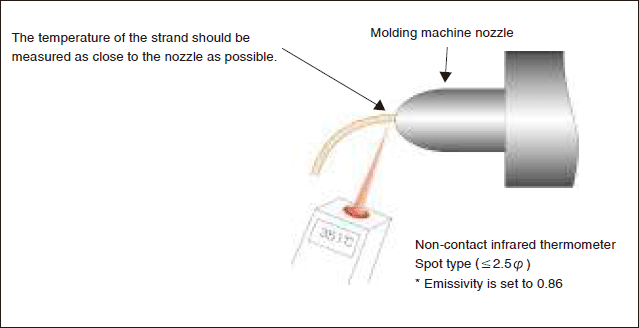
高速射出成形技術
スミカスーパーLCPは成形時の溶融粘度が低く、固化速度が速いため、バリが出にくい特徴があります。ただし超薄肉製品の成形(<0.2mm)においては、薄肉部で樹脂が固化し十分な流動長が得られない場合があります。こうした場合の対策として、射出時の立ち上がり特性に優れた電動射出成形機や、アキュムレータ付の油圧射出成形機の適用が有効です。
図4-3-2 バリ発生を伴わない最大流動長
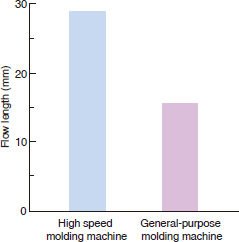
油圧射出成形機:
UH-1000[日精樹脂工業(株)]
電動射出成形機:
SE・SVシリーズ[住友重機械工業(株)]
電動射出成形機:
FANUC ROBOSHOT α-Siシリーズ[ファナック(株)]
電動射出成形機:
LP・TRシリーズ[ソディック(株)]
図4-3-3 射出速度波形の比較
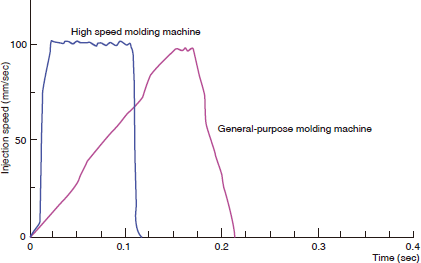
(汎用成形機と比較し、高速成形機は射出速度の初期立ち上がりが速く、所定の射出速度で成形されていることを示している)
| 流動長測定金型: | 図4-3-5のものを使用 |
| 成形温度: | 360℃ 使用グレード:E6008 射出速度 600mm/sec V-P切り替え圧力 60MPa |
| 汎用成形機: | 日精樹脂工業 PS-40E5 ASE 射出速度 90% 射出圧力 90MPa |
金型設計
スミカスーパーLCPは射出成形する(せん断をかける)ことにより、分子が容易に流れ方向に配向し、優れた流動性とともに高強度、高弾性な成形体が得られますが、一方で異方性が発生します。金型の設計にあたっては、キャビティ内の流動パターンと異方性を十分考慮する必要があります。
金型材質
- 試作および小ロットの成形に対しては、機械構造用炭素鋼(S55C)が使用できますが、摺動部を有する場合には焼き入れを推奨します。
- スミカスーパーLCPの標準グレードの多くはガラス繊維が充填されているため、高寸法精度が要求される金型や量産型では、硬度がHRC55~62のSKD11相当品(HPM31、PD613、RIGORなど)かそれ以上の鋼材の使用を推奨します。
- スミカスーパーLCPは腐食性のガスをほとんど発生しないため、金型を腐食させることがなく、一般的な金型材質が使用することができますが、金型硬度がHRC55未満の材質をご使用される場合は、事前に問題が無いか十分にご検討ください。
スプル
- スプルの抜き勾配は1゚~2゚(片側)が適切です。
- コールドスラグを取り除くため、スプルエンドにはコールドスラグ溜りを設けることを推奨します。(4~5mmφ×5mm以上)。
- スプル抜けを良くするため、スプルロックを設けることを推奨します。
図4-3-4 スプル図
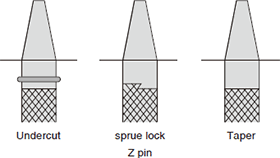
ランナ
- 一般的な円形、半円、台形、半台形の断面形状のランナが適用できますが、圧力損失と加工性から、円形もしくは半台形を推奨します。スミカスーパーLCPは優れた流動性を有しているため、ランナ径を細くすることができます。標準的なランナ径は2~5mmφで、ランナ径の目安としては、PPS、PBTの2/3~1/2(最小1.5mmφ程度)を推奨します。
- 多数個取りの場合、個々のキャビティに樹脂が同時充填するようランナバランスをとることを推奨します。ランナ末端にもコールドスラグ溜まりを設けてください。
図4-3-5 薄肉流動長測定金型(単位: mm)
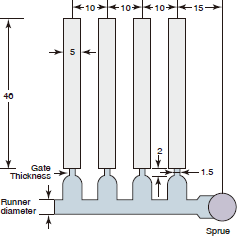
製品厚み:0.3mm
流動長は4キャビティ
図4-3-6 薄肉流動長
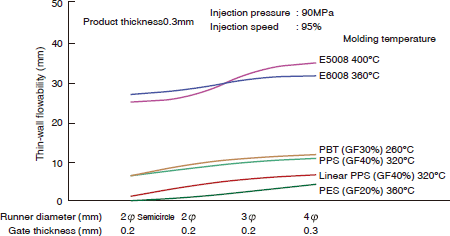
ゲート
スミカスーパーLCPはウエルド強度が他のエンプラに比べ低いため、できるだけウエルドが発生しないよう、ゲートは極力1点とし、ゲート位置を十分考慮する必要があります。
- サイドゲート
ランド長さは1mm以下、幅は5mm以下が適当です。ランド深さは0.7×成形品厚みを目安とし、最小0.2mmが適当です。 - ピンポイントゲート
ゲート径は0.3~1.5mm、ランド長さは1mm以下が適当です。
ゲート径を太くすると、糸引きやゲートめくれの原因となります。 - サブマリン(トンネル)ゲート
ゲート径は0.3~1.0mmが適当です。 - フィルムゲート、リングゲートを用いることも可能ですが、LCPではあまり一般的ではありません。
図4-3-7 ゲート図

抜きテーパー
- 成形品厚みの浅いもので0.5°(1/90)~1°(1/60)、深いものでは1°(1/60)~2°(1/30)とることが適当です。
- 良離型(MR)グレードは、一般グレードに比べて離型抵抗は約1/2ですが、成形品の深さが大きいものでは、抜きテーパーを大きくする必要があります。
エアベント(ガス抜き)
- スミカスーパーLCPの成形は高速射出条件である場合が多いため、製品部の空気を効率的に排除するために、エアベントを設けてください。
- 薄肉製品や流動末端がウエルドの場合、ショートショットやウエルド強度が不足するため、必ずエアベントを設けてください。
- スミカスーパーLCPは溶融粘度が低く流動性に優れますが、固化速度が非常に速いため、エアベントを設けてもバリは発生しにくいです。
- エアベントの深さは0.005~0.02mmが適当です。
ホットランナの適用
一般的に樹脂は長期連続成形において成形機内のデッドスペース部に滞留し、滞留樹脂が劣化、着色することがあります。溶融粘度が極めて低いLCPでは、このデッドスペース部の滞留が起こりやすいと考えられます。そのため、これらを考慮したホットランナが望ましく、特に樹脂の滞留による黒点、コールドスラグが発生しないように十分な注意が必要です。
スミカスーパーLCPへのホットランナの適用ポイント
スミカスーパーLCPのホットランナの選定の際は、下記のポイントに注意してください。
-
高温加熱が可能でシステム内の温度分布が均一であること。
ヒーター一体型が望ましい。過度にマニホールド、ノズルの温度は高くしないこと。
金型との接触部(ゲート部分)の温度を高温に保持できること。表4-3-1 ホットランナの温度仕様
ホットランナの温度仕様(MAX) E6000HFシリーズ ~370℃ E6000シリーズ ~380℃ E4000シリーズ ~400℃ E5000シリーズ ~420℃ - 流路にデッドスペースができにくい構造であること。
(滞留による黒点の発生に注意が必要)
加熱方式は、内部加熱方式より外部加熱方式の方が好適で、流路は細い方が良い。 - コールドスラグが混入しにくい構造であること。
(製品のコールドスラグの混入に注意が必要)
オープンゲートの場合はサブランナの設置を考慮した方が良い(スプルレス成形)。
スミカスーパーLCPへのホットランナの適用
表4-3-2 スミカスーパーLCPへのホットランナの適用
| ランナ部 | ゲートシール | スミカスーパー LCPへの適用 |
備考 | ||||||
|---|---|---|---|---|---|---|---|---|---|
| 内部 加熱 |
外部 加熱 |
オー プン |
バルブ ゲート |
熱シール | 完全 ホットランナ |
スプルレス 成形 |
|||
| (株)十王 614システム |
- | ✓ | - | - | ✓ | - | ○ | φ4 電磁誘導加熱 |
|
| 明星金属(株) ミニランナ |
- | ✓ | ✓ | - | - | × | ○ | *1 | |
| 世紀工業(株) スピアシステム |
Bタイプ(従来) | ✓ | - | - | - | ✓ | × | × | |
| EHタイプ | - | ✓ | - | - | ✓ | × | ○ | *2 | |
| モールドマスター(株) マスターショット |
- | ✓ | ✓ | ✓ | - | × | ○ | ||
| 斉藤工機(株) プラゲートシステム |
- | ✓ | - | - | ✓ | × | - | ||
○:スミカスーパー LCPへの適用可。
×:スミカスーパー LCPへの適用不可。
| *1: | 多点ゲートで、且つミニランナ用延長ノズルを用いる場合は、各延長ノズルを個々に温度コントロールする方が望ましい。また、成形温度の高いE5000系も各ノズルを個別に温度コントロールする方が望ましい。 |
| *2: | チップ部は内部加熱方式 |
